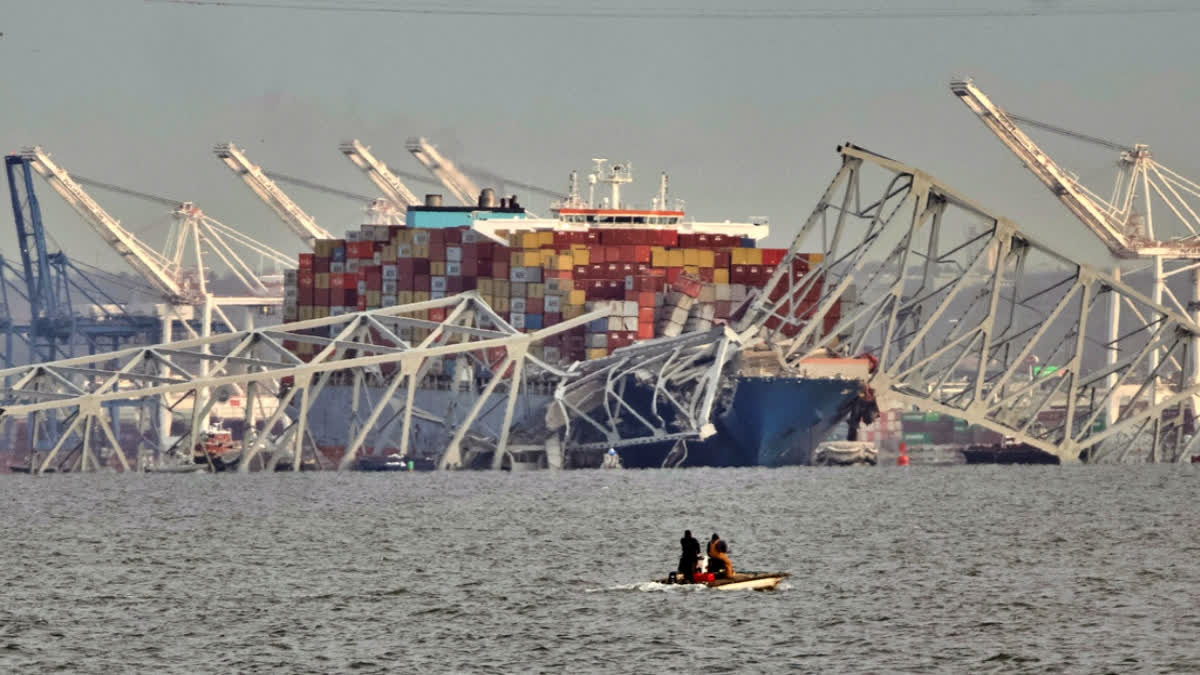New Delhi: When the container ship MV Dali carrying cars from the Baltimore Port in the US to Sri Lanka collided with the Francis Scott Key Bridge over the Patapsco River, attention immediately turned to the broader implications for maritime navigation and the urgent need for enhanced safety measures to prevent similar disasters in the future.
Though the crew members of the MV Dali, all Indians, are safe, six construction workers are believed to have fallen from the collapsing bridge into the frigid waters of the Patapsco River below. The bodies of two of the victims have been recovered so far, while four remain missing and are presumed dead, officials said.
The incident, which occurred around 1:30 am local time on Tuesday, has severely disrupted maritime navigation and vehicular traffic across the bridge. The 2.4-km Francis Scott Key Bridge was a steel arch continuous through truss bridge that spanned the lower Patapsco River and outer Baltimore Port carrying the Baltimore Beltway (Interstate 695) between Hawkins Point, a neighbourhood of Baltimore, and Dundalk in Maryland, a mid-Atlantic state in the US.
Apart from the tragic human casualties, an immediate concern that has arisen is how maritime traffic emanating from Baltimore Port will be affected. The Helen Delich Bentley Port of Baltimore is a shipping port along the tidal basins of the three branches of the Patapsco River in Baltimore on the upper northwest shore of the Chesapeake Bay.
The port is ranked as the ninth-largest port in the US by foreign cargo value. It handles a huge amount of bulk cargo, including more automobiles, forest products, aluminium, iron ore, and sugar than any other US port. It is a leading US port for roll-on/roll-off cargo like cars, trucks, construction equipment and other specialised cargo, and is a major hub for international cargo, with regular shipping lines connecting it to all six inhabited continents.
Given that the maritime traffic from Baltimore port has been disrupted following Tuesday’s incident, what will the economic implications be? According to Subrata K Behera, Senior Manager (Ports and Container Research) at Drewry Maritime Research, the economic implications due to the disruption of maritime traffic from the Baltimore port will not be much.
“The total volume of cargo handled by ports on the east coast of the US is 30 million TEU (twenty-foot equivalent unit) per annum,” Behera told ETV Bharat. “Out of this, the Baltimore Port accounts for only one million TEU.” And what about cargo ships heading for the Baltimore Port?
“Depending on the cargo, ships will be redirected to nearby ports on the east coast like New York-New Jersey or Philadephia,” Behera said. “After that, the cargo will be transported to the respective destinations via railways and trucks at a slightly extra cost.”
Among the major ports on the eastern coast of the US are the New York/New Jersey Port Complex (including ports in New York City and Newark, New Jersey), Port of Philadelphia, Pennsylvania, Port of Savannah, Georgia, Port of Charleston, South Carolina, Port of Norfolk, Virginia, Port of Miami, Florida, Port of Jacksonville, Florida, Port Everglades, Florida (Fort Lauderdale), Port of Wilmington, Delaware, and Port of Boston, Massachusetts. Of these, the Port of Norfolk also serves as the world’s largest naval station.
Now, let’s look at what caused the MV Dali to crash into the Francis Scott Key Bridge after the power got cut off that fateful night. Behera explained that the pilots of the ship lost control of the steering wheel.
Behera explained that the level of the Patapsco River when the out-of-control MV Dali veered towards the bridge also needs to be examined. The MV Dali is a container ship with an overall length of 299.92 metres (984 ft), beam of 48.2 metres (158 ft 2 in), moulded depth of 24.8 metres (81 ft 4 in), and summer draft of 15.03 metres (49 ft 4 in). Now, how long will it take to reconstruct the Francis Scott Key Bridge and restore maritime traffic from the Baltimore Port?
“See, the bridge was constructed in the 1970s at today’s value of $350 million,” Robinder Sachdev, president of the independent think tank ImagIndia, told ETV Bharat. An engineer by profession, Sachdev had lived in the Baltimore area for around seven years.
“President Joe Biden and Transport Secretary Pete Buttigieg have taken the reconstruction of the bridge on a priority basis,” he said. “They have already allocated a budget for this. Given today’s technology, it will take around 18 months to reconstruct the bridge.” Sachdev further explained that Baltimore is primarily a seaport town. “The collapse of the bridge will affect the livelihoods of around 100,000 people,” he said.
Read More



